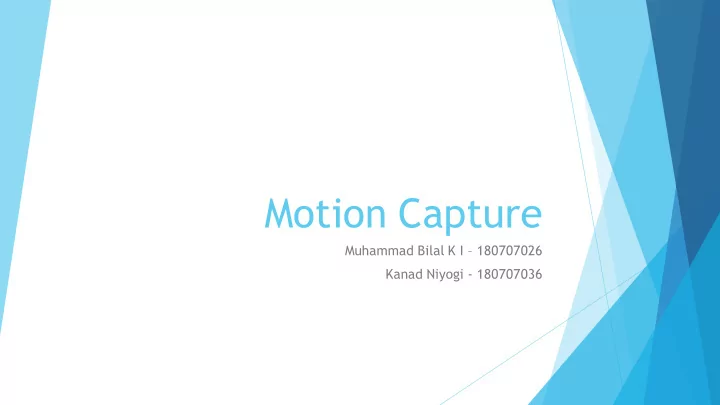

Motion Capture Muhammad Bilal K I – 180707026 Kanad Niyogi - 180707036
Contents Introduction History of Motion Capture Key Frame Animation Vs Motion Capture Technology Applications Advantages Conclusion Bibliography
Introduction Popularly known as “ Mocap ” 3D representation of a live performance Performers actions are digitally recorded by cameras which track points on the performer’s body such as hands, head , legs and feet.
HISTORY OF MOTION CAPTURE Rotoscoping is an animation technique in which animators trace cartoon characters over photographed frames of live performance
Facial works primarily depend on key frame animation. Body movements and for quicker actions, one largely use mocap. The amount of work does not vary with the complexity of the sequence. Using mocap, a single actor can play multiple in the same film.
TECHNOLOGY BEHIND MOTION CAPTURE Mechanical Motion Capture Optical Motion Capture Magnetic Motion Capture
MECHANICAL MOTION CAPTURE Technique achieved through the use of an exoskeleton. Each joint is connected to an angular encoder. The “skeleton data” recorded can be “skinned” to look like any character. Offers high precision and not being influenced by external factors
OPTICAL MOTION CAPTURE Optical shooting with several synchronised cameras. The cameras emit radiation reflected by the markers and then returned to the same cameras The markers will be viewed as white spots and the position in virtual space can be determined.
MAGNETIC MOTION CAPTURE Utilize sensors placed on the body to measure the low-frequency magnetic field generated by a transmitter source The sensors reports position and rotational information.
APPLICATIONS Entertainments Medicine Sports
ENTERTAINMENTS Motion capture represents the future of digital content creation. Film, television and interactive media all use motion capture in a growing number of its productions. In the name industry, manufacturers are using motion capture sytems.
KING KONG Sinbad: Beyond the veil of mists
MEDICINE Gait analysis is the major application of motion capture in clinical medicine Motion capture allows clinical to evaluate human motion, without burdening patients with body suites or tracking devices.
SPORTS Motion capture is ideal for a wide range of sports applications in research, rehabilitation, physical education and practice. Developing Digital sports Games Also allows to learn more about injury mechanisms and prevention.
ADVANTAGES More rapid, sometimes even real time results can be obtained Complex movement and realistic physical interactions can be recreated in a physically accurate manner. Costumes, make-ups, body size and age can be changed to whatever is needed. The Versatility and flexibility of the mocap system makes it suitable for many applications within psychology
CONCLUSION The purpose of these technologies is to allow us to create characters and effects that we could not do before, and do it more realistically and efficiently than ever before They allow us to create and interact with virtual worlds and blend the lines between reality and fantasy Motion capture tools are becoming more flexible and more powerful these days.
BIBLIOGRAPHY http://web.mit.edu http://www.siggraph.org http://www.metamotion.com http://www.postmagazine.com
THANK YOU
Recommend
More recommend